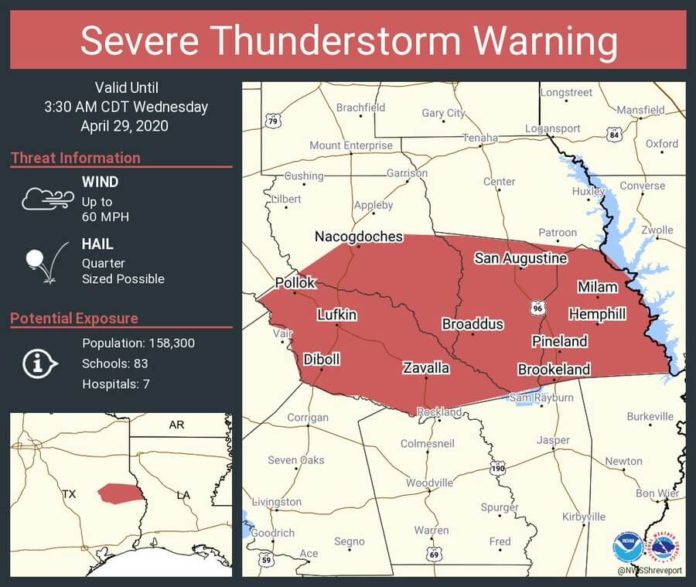According to the National Weather Service, there is a slight 15 percent chance for severe storms Tuesday night into early Wednesday morning across parts of the USA.
Warning Coordination Meteorologist Roger Erickson said the highest threat region is in southeast Texas and parts of central, south central and southwest Louisiana.
The National Weather Service in Shreveport has stated that Webster parish is at an enhanced risk of severe weather on Tuesday, April 28. Potential threats include damaging winds, hail, and a low chance of tornadoes.
“We do have another threat of severe weather tomorrow,” said Dayvon Hill, Meteorologist. “It looks like a major threat at the moment is going to be damaging winds, but we can’t rule out a tornado.”
Hill also stated that while hail is a possibility, it likely won’t be like what the area saw a few days ago.
“Hail will be possible as well, but I don’t think we’ll see the type of hail we saw a couple of days ago, but severe hail is definitely a possibility,” said Hill.
He also stated that it looks like the time our area will be seeing the severe weather is between midnight and 5 a.m.
Though after the storm, Webster Parish should experience dry and cool weather in the following days.
“The weather should be dry through the rest of the week with slightly cooler weather behind it. Around a 5 to 10-degree drop in temperature in the following days,” said Hill.
The Tuscaloosa area has a slight risk of severe weather developing on Wednesday, according to the National Weather Service.
From noon until 8 p.m. Wednesday, forecasters say rain, winds up to 60 miles per hour and hail could develop in central Alabama.
Wednesday’s high will be near 74 degrees in the Tuscaloosa area with a 90% chance of precipitation.
Sunny skies and high temperatures near 80 degrees are in the Tuesday forecast, with rain and wind moving in Tuesday night and continuing Wednesday.
What cause Tornado?
Tornadoes are vertical funnels of rapidly spinning air. Their winds may top 250 miles an hour and can clear a pathway a mile wide and 50 miles long.
Also known as twisters, tornadoes are born in thunderstorms and are often accompanied by hail. Giant, persistent thunderstorms called supercells spawn the most destructive tornadoes.
These violent storms occur around the world, but the United States is a major hotspot with about a thousand tornadoes every year.
What cause hailstorm?
Hail is large, layered ice particles, often spherical in shape, which are produced by thunderstorms having strong, tilted updrafts.
Hailstorms form within a unusually unstable air mass, that is, an air mass in which the temperature falloff with height is much greater than normal. The unstable air is necessary to produce large updraft speeds — fast enough to keep a developing hailstone from falling to the ground. Some of these updrafts can reach 60 mph or more.
In a hailstorm, small ice particles that form above the freezing level (which occurs in all thunderstorms) collect either rain water or cloud water on them, forming a water shell that freezes.
